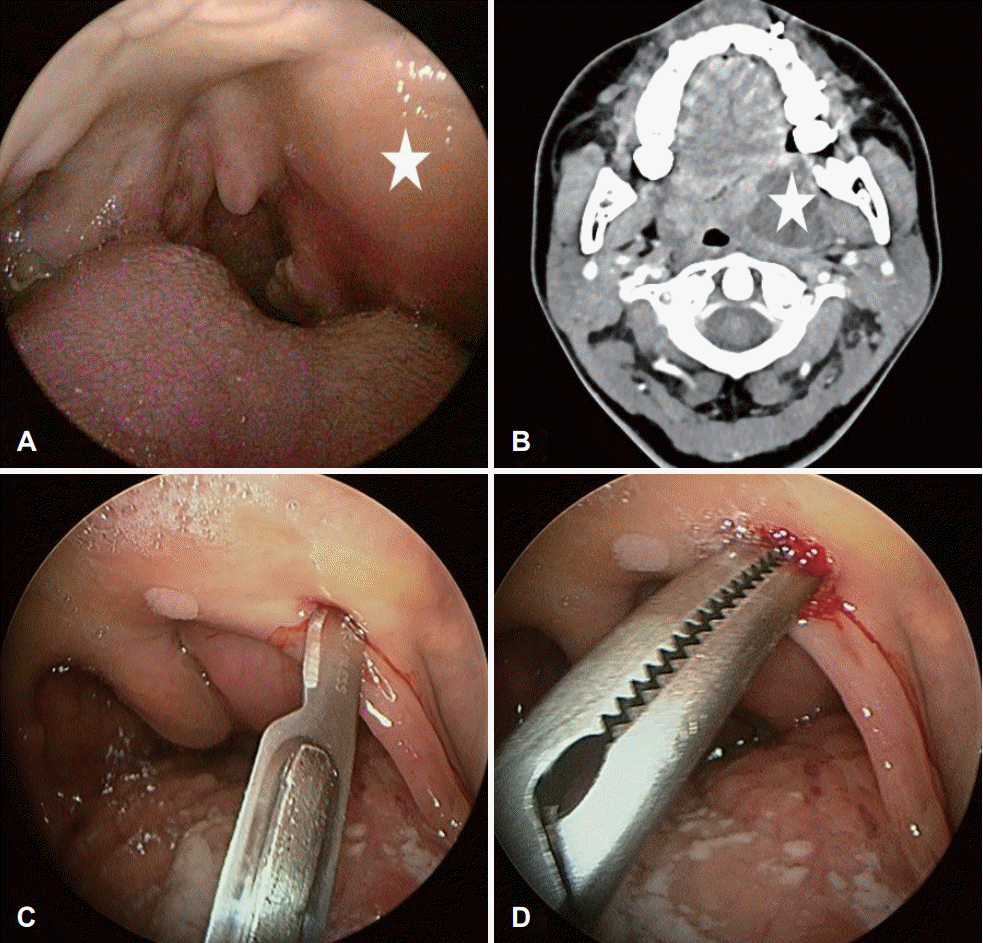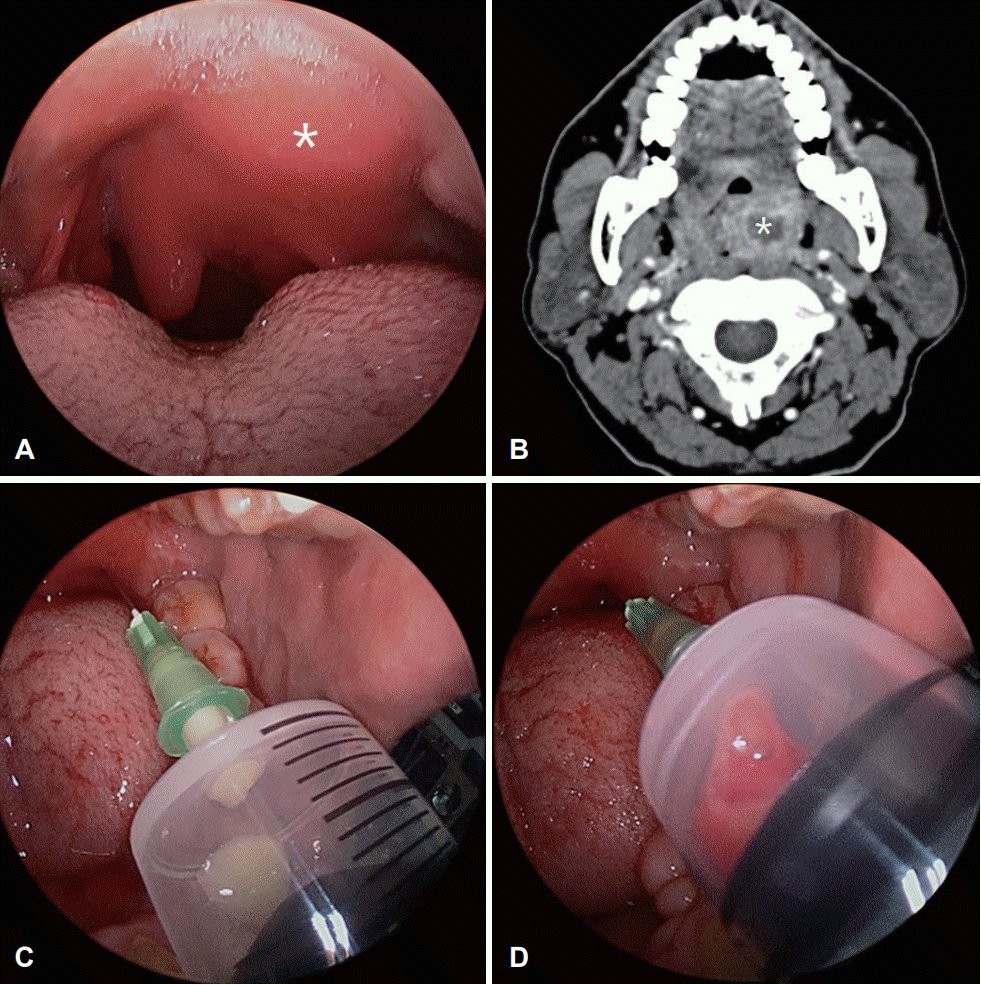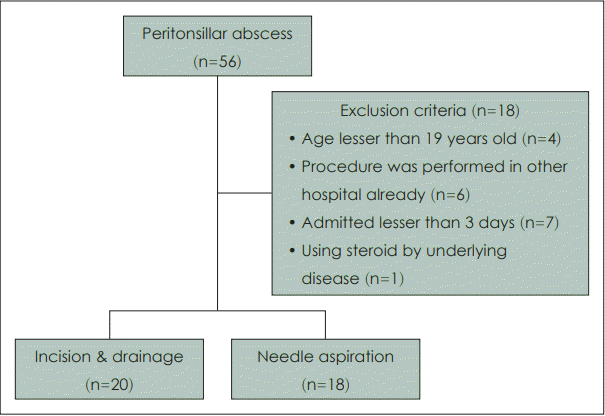1. Klug TE, Henriksen JJ, Fuursted K, Ovesen T. Significant pathogens in peritonsillar abscesses. Eur J Clin Microbiol Infect Dis. 2011; 30(5):619–27.
2. Bakir S, Tanriverdi MH, Gün R, Yorgancilar AE, Yildirim M, Tekbaş G, et al. Deep neck space infections: A retrospective review of 173 cases. Am J Otolaryngol. 2012; 33(1):56–63.
3. Herzon FS. Peritonsillar abscess: Incidence, current management practices, and a proposal for treatment guidelines. Laryngoscope. 1995; 105(S3):1–17.
4. Hanna BC, McMullan R, Gallagher G, Hedderwick S. The epidemiology of peritonsillar abscess disease in Northern Ireland. J Infect. 2006; 52(4):247–53.
5. Sunnergren O, Swanberg J, Mölstad S. Incidence, microbiology and clinical history of peritonsillar abscesses. Scand J Infect Dis. 2008; 40(9):752–5.
6. Lee JH, Park JG, Lee JD, Kim DW, Lee BD, Chang HS. A clinical analysis of peritonsillar abscess. J Clinical Otolaryngol. 2003; 14(2):282–7.
7. Giger R, Landis BN, Dulguerov P. Hemorrhage risk after quinsy tonsillectomy. Otolaryngol Head Neck Surg. 2005; 133(5):729–34.
8. Windfuhr JP, Chen YS. Immediate abscess tonsillectomy--a safe procedure? Auris Nasus Larynx. 2001; 28(4):323–7.
9. Windfuhr JP, Zurawski A. Peritonsillar abscess: Remember to always think twice. Eur Arch Otorhinolaryngol. 2016; 273(5):1269–81.
10. Chang BA, Thamboo A, Burton MJ, Diamond C, Nunez DA. Needle aspiration versus incision and drainage for the treatment of peritonsillar abscess. Cochrane Database Syst Rev. 2016; 12(12):CD006287.
11. Khokhar MR, Raza SN, Ayaz SB. Comparison of efficacy of needle aspiration versus incision and drainage in management of peritonsillar abscess. Pak Armed Forces Med J. 2015; 65(Suppl 2):S172–7.
12. Spires JR, Owens JJ, Woodson GE, Miller RH. Treatment of peritonsillar abscess. A prospective study of aspiration vs incision and drainage. Arch Otolaryngol Head Neck Surg. 1987; 113(9):984–6.
13. Wolf M, Even-Chen I, Kronenberg J. Peritonsillar abscess: Repeated needle aspiration versus incision and drainage. Ann Otol Rhinol Laryngol. 1994; 103(7):554–7.
14. Chi T, Yuan C, Tsao Y. Comparison of needle aspiration with incision and drainage for the treatment of peritonsillar abscess. WIMJ Open. 2014; 1(1):11–3.
15. Galioto NJ. Peritonsillar abscess. Am Fam Physician. 2017; 95(8):501–6.
16. Johnson RF, Stewart MG, Wright CC. An evidence-based review of the treatment of peritonsillar abscess. Otolaryngol Head Neck Surg. 2003; 128(3):332–43.
17. Mansour C, De Bonnecaze G, Mouchon E, Gallini A, Vergez S, Serrano E. Comparison of needle aspiration versus incision and drainage under local anaesthesia for the initial treatment of peritonsillar abscess. Eur Arch Otorhinolaryngol. 2019; 276(9):2595–601.
18. Forner D, Curry DE, Hancock K, MacKay C, Taylor SM, Corsten M, et al. Medical intervention alone vs surgical drainage for treatment of peritonsillar abscess: A systematic review and meta-analysis. Otolaryngol Head Neck Surg. 2020; 163(5):915–22.
19. Zebolsky AL, Dewey J, Swayze EJ, Moffatt S, Sullivan CD. Empiric treatment for peritonsillar abscess: A single-center experience with medical therapy alone. Am J Otolaryngol. 2021; 42(4):102954.
20. Urban MJ, Masliah J, Heyd C, Patel TR, Nielsen T. Peritonsillar abscess size as a predictor of medical therapy success. Ann Otol Rhinol Laryngol. 2022; 131(2):211–8.






 PDF
PDF Citation
Citation Print
Print




 XML Download
XML Download